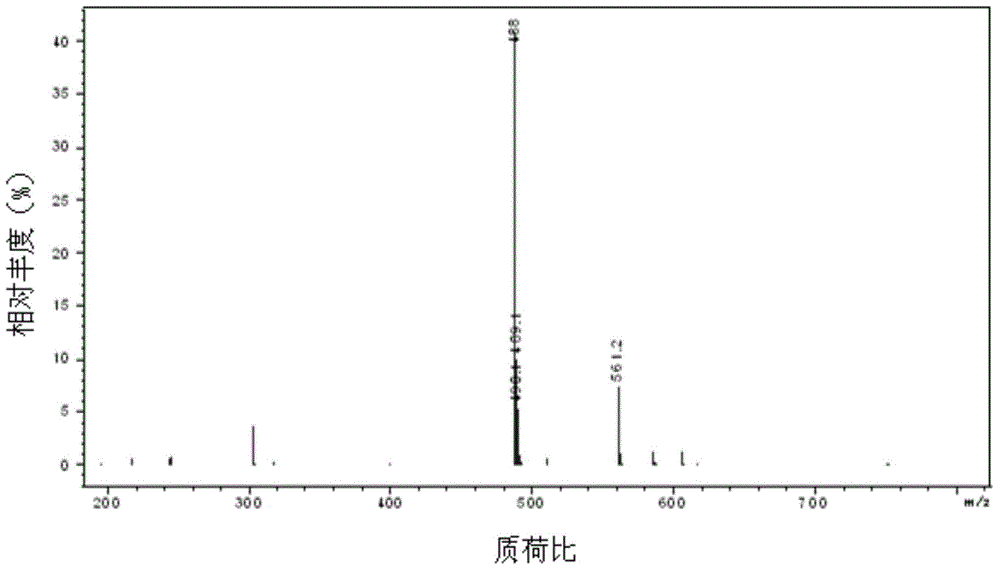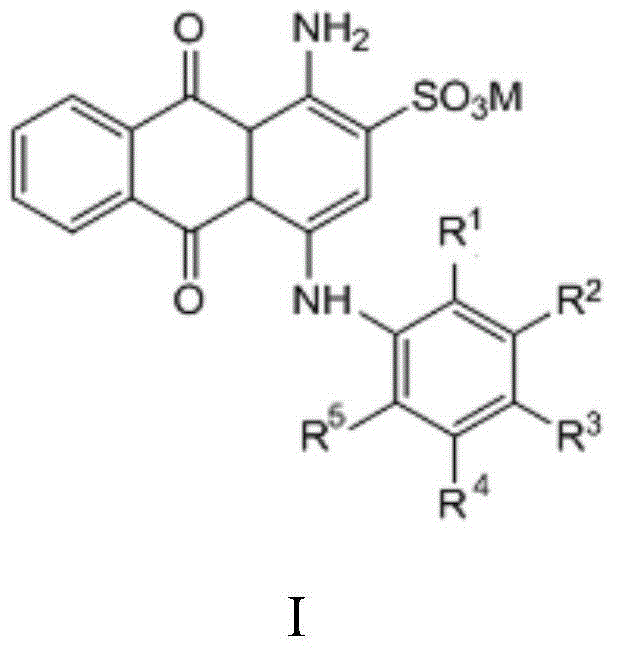Method for synthesizing anthraquinone type dye or chromophore by aromatic amination of bromamine acid
A bromamic acid arylamine, anthraquinone type technology, which is applied in the field of dyes, can solve the problems of reducing the amount of catalyst used and converting bromamic acid to COD, etc.
- Summary
- Abstract
- Description
- Claims
- Application Information
AI Technical Summary
Problems solved by technology
Method used
Image
Examples
Embodiment 1
[0052] Weigh 8.4 g of sodium 2,4-diaminobenzenesulfonate, 8.4 g of sodium bicarbonate, and 20 ml of water, add them into a container equipped with a stirrer, condenser, and thermometer, and heat to 80°C while stirring. Weigh respectively 8.08 grams of bromine, 15% mol (based on bromine) of monovalent copper and 1,4,7,10-tetraazacyclododecane-1,3-diene (C 8 h 18 N 4 ) complex aqueous solution. Alternately add solid bromine and monovalent copper complexes into the container within 1 hour, keep the reaction temperature at 80-82°C, the pH of the reaction system at 9, and stir for 3 hours; raise the reaction temperature to 85-90°C, Stir the reaction, take a sample for thin-layer chromatography and liquid chromatography analysis, and no bromidine is the end point of the reaction. In the reaction liquid mixture, there are no hydrolyzed products of bromoacidic acid (purple side) and bicondensates, but there are traces of debrominated products.
[0053] The above materials were coo...
Embodiment 2
[0055] Weigh 21 grams of 2,4-diaminobenzenesulfonic acid, 26.5 grams of sodium carbonate, and 50 milliliters of water, add them into a container equipped with a stirrer, a condenser, and a thermometer, and heat to 80°C while stirring. Weigh respectively 20.2 grams of bromine, 10% mol (based on bromine) of monovalent copper and 1,4,7,10-tetraazacyclododecane-1,3-diene (C 8 h 18 N 4 ) complex aqueous solution. Alternately add solid bromine and monovalent copper complexes into the container within 2.5 hours, keep the reaction temperature at 80-82°C, the pH of the reaction system at 9, stir for 3 hours; raise the reaction temperature to 85-90°C, Stir the reaction, take a sample for thin-layer chromatography and liquid chromatography analysis, and no bromidine is the end point of the reaction. In the reaction liquid mixture, there are no hydrolyzed products of bromoacidic acid (purple side) and bicondensates, but there are traces of debrominated products.
[0056] The above mat...
Embodiment 3
[0058] Weigh 8.4 g of 2,4-diaminobenzenesulfonic acid, 8.4 g of sodium bicarbonate, and 20 ml of water, add them into a container equipped with a stirrer, a condenser, and a thermometer, and heat to 80°C while stirring. Weigh respectively 8.08 grams of bromine, 10% mol (based on bromine) of monovalent copper and 1,4,7,10-tetraazacyclododecane-1,3-diene (C 8 h 18 N 4 ) complex ethanol solution. Alternately add solid bromine and monovalent copper complexes into the container within 1 hour, keep the reaction temperature at 80-82°C, the pH of the reaction system at 9, and stir for 2 hours; raise the reaction temperature to 80-90°C, Stir the reaction, take a sample for thin-layer chromatography and liquid chromatography analysis, and no bromidine is the end point of the reaction. In the reaction liquid mixture, there are no hydrolyzed products of bromoacidic acid (purple side) and bicondensates, but there are traces of debrominated products.
[0059] The above materials were co...
PUM
 Login to View More
Login to View More Abstract
Description
Claims
Application Information
 Login to View More
Login to View More - R&D
- Intellectual Property
- Life Sciences
- Materials
- Tech Scout
- Unparalleled Data Quality
- Higher Quality Content
- 60% Fewer Hallucinations
Browse by: Latest US Patents, China's latest patents, Technical Efficacy Thesaurus, Application Domain, Technology Topic, Popular Technical Reports.
© 2025 PatSnap. All rights reserved.Legal|Privacy policy|Modern Slavery Act Transparency Statement|Sitemap|About US| Contact US: help@patsnap.com



